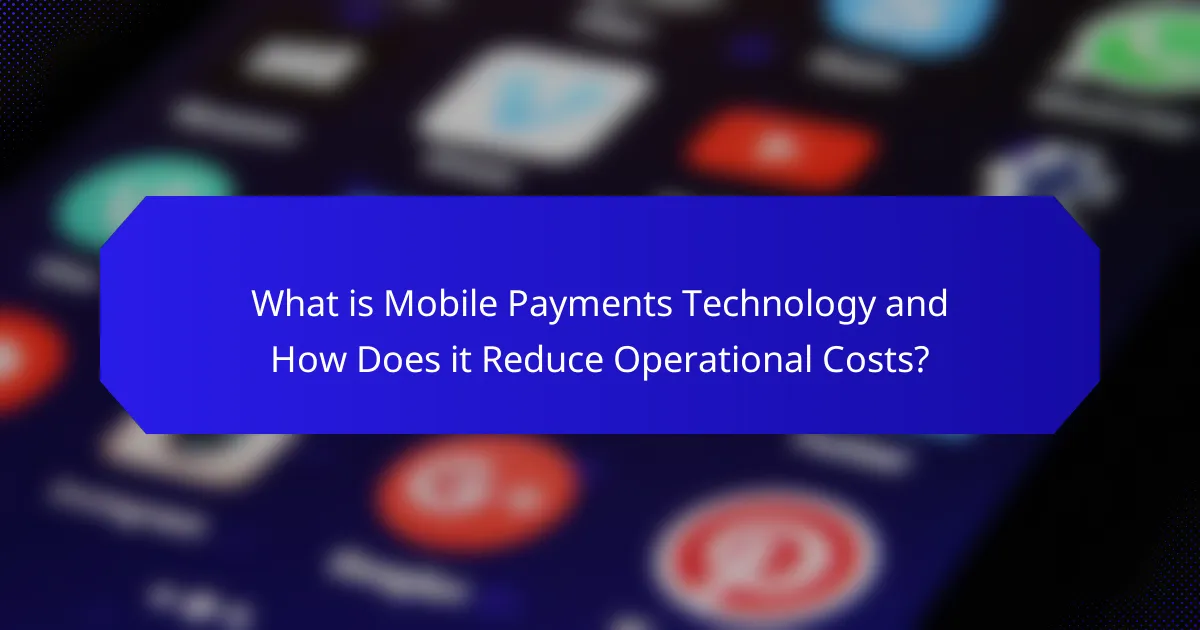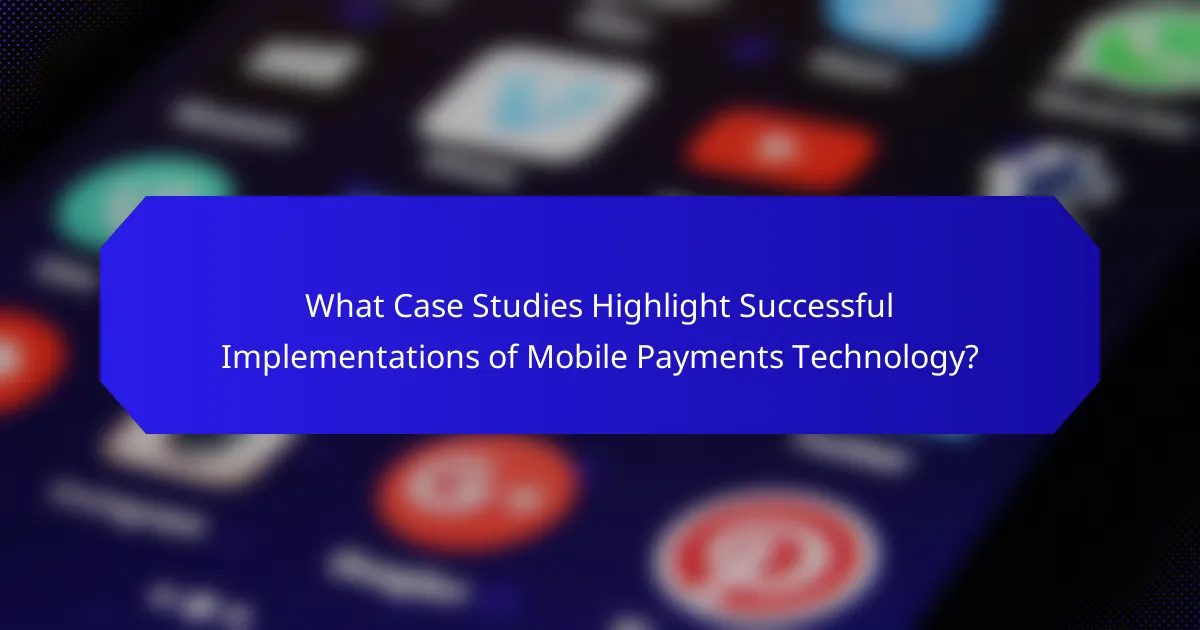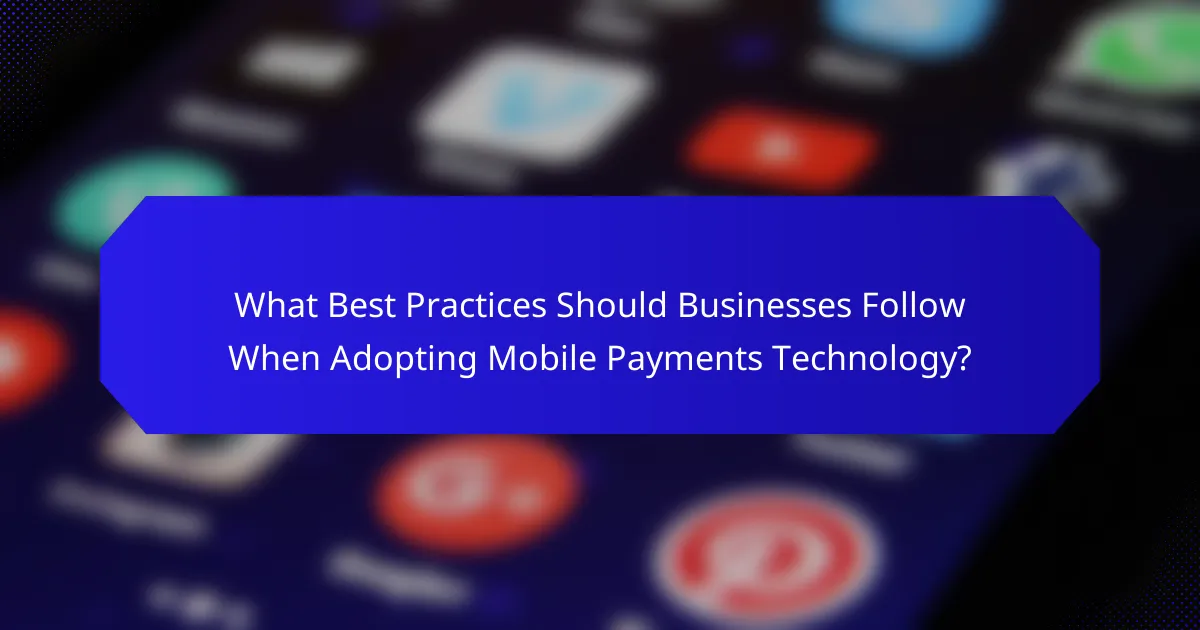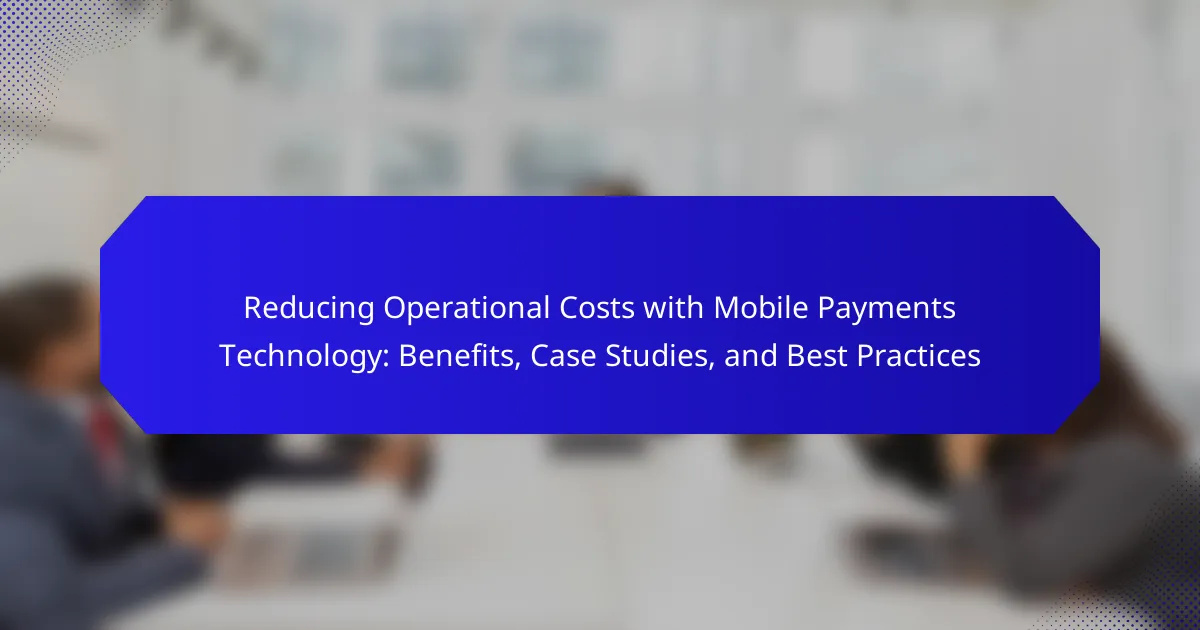Mobile payments technology involves the use of smartphones and tablets to conduct financial transactions, allowing consumers to pay using apps or digital wallets. This technology reduces operational costs by minimizing cash handling and associated security measures, with potential processing cost reductions of up to 50%. Successful implementations by companies like Starbucks and Square demonstrate significant increases in sales and customer satisfaction. Key considerations for businesses adopting mobile payments include security, user experience, and system integration, all of which contribute to improved operational efficiency and customer trust.

What is Mobile Payments Technology and How Does it Reduce Operational Costs?
Mobile payments technology refers to the use of mobile devices to conduct financial transactions. This technology enables consumers to make payments via smartphones or tablets using apps or digital wallets. It reduces operational costs by minimizing the need for physical cash handling and associated security measures. Businesses can save on transaction fees compared to traditional payment methods. According to a study by McKinsey, mobile payments can lower processing costs by up to 50%. Additionally, it enhances efficiency by speeding up transaction times, leading to improved customer satisfaction and retention. Overall, mobile payments streamline operations and reduce overhead expenses.
How does Mobile Payments Technology function in various industries?
Mobile payments technology functions by enabling secure transactions through smartphones and other mobile devices. In retail, it allows customers to make purchases via apps or contactless payments, streamlining checkout processes. In the hospitality industry, mobile payments facilitate quick billing and enhance customer experience through mobile ordering. Healthcare uses mobile payments for patient billing, improving payment collection efficiency. Transportation services implement mobile payments for ticket purchases, reducing cash handling costs. According to a 2021 report by Statista, mobile payment transaction values are projected to reach $12 trillion by 2025, highlighting the growing adoption across sectors.
What are the key components of Mobile Payments Technology?
The key components of Mobile Payments Technology include mobile devices, payment gateways, and security protocols. Mobile devices serve as the primary interface for transactions. Payment gateways facilitate the processing of payment information between the customer and the merchant. Security protocols ensure the protection of sensitive data during transactions. These components work together to enable seamless and secure financial exchanges. According to a report by Statista, the mobile payment market is projected to reach over $4.5 trillion by 2023, highlighting the technology’s growing importance.
How do these components contribute to cost reduction?
Mobile payments technology contributes to cost reduction by streamlining transaction processes and minimizing operational overhead. It reduces the need for physical cash handling, which decreases labor costs and the risk of theft. Automated payment systems lower processing fees compared to traditional banking methods. Additionally, mobile payments enhance customer experience, leading to increased sales and repeat business. According to a study by the Federal Reserve, mobile payments can decrease transaction times by up to 50%, further reducing costs associated with long checkout lines. Overall, these components create a more efficient financial ecosystem that drives down operational expenses.
What are the primary benefits of implementing Mobile Payments Technology?
Mobile payments technology offers numerous primary benefits. It enhances transaction speed, allowing customers to complete purchases quickly. This efficiency can lead to increased customer satisfaction and retention. Mobile payments also reduce operational costs by minimizing cash handling and associated security risks. According to a report by McKinsey, businesses can save up to 20% on transaction costs by adopting mobile payment solutions. Additionally, mobile payments provide valuable data analytics, enabling businesses to understand consumer behavior better. This insight can drive targeted marketing strategies and improve sales. Overall, implementing mobile payments technology streamlines operations and supports cost reduction.
How does Mobile Payments Technology enhance customer experience?
Mobile payments technology enhances customer experience by providing convenience and speed. Customers can complete transactions quickly using their smartphones. This reduces wait times at checkout, improving overall satisfaction. Additionally, mobile payments offer a seamless integration with loyalty programs. Customers can earn rewards automatically during purchases. Security is also enhanced, as mobile payments often use encryption and tokenization. This builds trust with users, further enhancing their experience. According to a study by Statista, 53% of consumers prefer mobile payments for their speed and ease of use. This demonstrates the significant impact mobile payments have on customer preferences.
What financial savings can businesses expect from Mobile Payments Technology?
Businesses can expect significant financial savings from Mobile Payments Technology. This technology reduces transaction fees compared to traditional payment methods. For example, mobile payments can lower credit card processing fees by up to 25%. Additionally, businesses save on hardware costs, as mobile payments often require less expensive equipment.
Implementing mobile payments can also decrease labor costs. Employees spend less time processing transactions, leading to increased efficiency. Moreover, faster transaction times can enhance customer satisfaction, resulting in higher sales volumes.
According to a study by the Federal Reserve, mobile payments can improve cash flow management for businesses. This is due to quicker fund availability. Overall, mobile payments streamline operations, leading to lower operational expenses and increased profitability.

What Case Studies Highlight Successful Implementations of Mobile Payments Technology?
Starbucks and Square are notable case studies highlighting successful implementations of mobile payments technology. Starbucks integrated its mobile app for ordering and payment, resulting in a 20% increase in sales. This app allows customers to pay ahead, reducing wait times. Square enabled small businesses to accept mobile payments easily. This increased transaction speed and customer satisfaction. In 2020, Square reported a 50% growth in mobile payment transactions. Both cases demonstrate how mobile payments can enhance operational efficiency and customer experience.
What are some notable examples of businesses using Mobile Payments Technology?
Starbucks, McDonald’s, and Amazon are notable examples of businesses using mobile payments technology. Starbucks utilizes its mobile app for payments, allowing customers to order and pay in advance. This has increased customer convenience and loyalty. McDonald’s has integrated mobile payments through its app, streamlining the ordering process and reducing wait times. Amazon Go stores use a cashless system where customers scan their smartphones to enter and automatically pay for items. These implementations demonstrate how mobile payments enhance efficiency and customer experience across different industries.
How did these businesses achieve cost reduction through Mobile Payments?
Businesses achieved cost reduction through mobile payments by streamlining transaction processes. Mobile payments lower transaction fees compared to traditional credit card processing. They also reduce the need for physical cash handling and the associated costs of theft and loss. Automation in payment processing minimizes labor costs related to cash management. Additionally, mobile payment systems often provide real-time data analytics. This data helps businesses optimize inventory and reduce overstock. By enhancing customer experience, businesses can increase sales, further contributing to cost efficiency. According to a study by McKinsey, companies using mobile payments reported a 20% decrease in operational costs.
What lessons can be learned from these case studies?
Case studies on reducing operational costs with mobile payments technology reveal several key lessons. First, implementing mobile payments can streamline transaction processes. This leads to faster service and improved customer satisfaction. Additionally, businesses can reduce overhead costs associated with traditional payment methods. Case studies show that companies experience decreased transaction fees. Moreover, integrating mobile payments enhances financial tracking and reporting. This allows for better budget management and cost analysis. Finally, successful adoption requires training staff and promoting user engagement. These factors contribute to maximizing the benefits of mobile payment systems.
What challenges did these businesses face during implementation?
Businesses faced several challenges during the implementation of mobile payments technology. One major challenge was the integration with existing systems. Many businesses struggled to align new mobile payment solutions with their legacy payment systems. This often led to technical difficulties and increased costs.
Another challenge was employee training. Staff needed to adapt to new processes and technology, which required time and resources. Resistance to change among employees also hindered smooth implementation.
Security concerns were significant as well. Businesses worried about data breaches and fraud associated with mobile payments. Ensuring compliance with regulations added another layer of complexity.
Finally, customer acceptance was a challenge. Some customers were hesitant to adopt mobile payments, impacting the overall effectiveness of the technology. These factors collectively complicated the implementation process for many businesses.
How did they overcome these challenges?
They overcame these challenges by implementing comprehensive training programs. These programs educated staff on mobile payment systems and best practices. Additionally, they invested in user-friendly technology to streamline the payment process. This technology reduced transaction times and improved customer satisfaction. They also established partnerships with mobile payment providers for better support. Data analytics were utilized to monitor performance and identify areas for improvement. These strategies collectively enhanced operational efficiency and reduced costs.

What Best Practices Should Businesses Follow When Adopting Mobile Payments Technology?
Businesses should prioritize security, user experience, and integration when adopting mobile payments technology. Implementing robust security measures is essential. This includes encryption and compliance with PCI DSS standards. A seamless user experience encourages customer adoption. Businesses should ensure that the payment process is quick and intuitive. Integration with existing systems is crucial for operational efficiency. This allows for streamlined transactions and better data management. Regularly updating technology keeps the payment system secure and functional. Training staff on mobile payment systems enhances customer service. These practices collectively improve customer trust and reduce operational costs.
What strategies can businesses use to ensure a smooth transition to Mobile Payments?
Businesses can ensure a smooth transition to mobile payments by adopting several key strategies. First, they should conduct thorough market research to understand customer preferences and technology trends. This helps in selecting the right mobile payment solutions. Second, businesses must invest in employee training to familiarize staff with new systems and processes. Well-trained employees can assist customers effectively. Third, integrating mobile payment systems with existing infrastructure is crucial for seamless operations. This minimizes disruptions during the transition. Fourth, businesses should communicate the benefits of mobile payments to customers. Clear communication can enhance customer acceptance and usage. Lastly, implementing a phased rollout can allow for adjustments based on feedback and performance. This approach reduces risks associated with full-scale implementation. These strategies collectively facilitate a smoother transition to mobile payments, enhancing operational efficiency and customer satisfaction.
How can businesses train staff effectively for Mobile Payments Technology?
Businesses can train staff effectively for Mobile Payments Technology by implementing structured training programs. These programs should include hands-on demonstrations of mobile payment systems. Staff should engage in role-playing scenarios to simulate real transactions. Providing comprehensive manuals and quick reference guides can enhance understanding. Regular workshops and refresher courses keep knowledge current. Utilizing online training modules allows flexible learning at individual paces. Feedback mechanisms ensure staff can ask questions and clarify doubts. Studies indicate that businesses with thorough training see a 30% increase in transaction accuracy.
What security measures should be in place when adopting Mobile Payments?
Implementing robust security measures is essential when adopting mobile payments. Encryption protects sensitive data during transactions. Two-factor authentication adds an extra layer of security by requiring a second form of verification. Regular security audits help identify vulnerabilities in the payment system. Tokenization replaces sensitive card information with unique identifiers to reduce fraud risk. Compliance with standards like PCI DSS ensures adherence to security protocols. User education on safe practices further mitigates risks associated with mobile payments. These measures collectively enhance the security of mobile payment systems, protecting both consumers and businesses.
What common pitfalls should businesses avoid with Mobile Payments Technology?
Businesses should avoid several common pitfalls with mobile payments technology. First, they must ensure security measures are robust to prevent data breaches. According to a 2022 report by Verizon, 80% of data breaches involve weak security practices. Second, businesses should not overlook user experience. Complicated payment processes can lead to cart abandonment, with 27% of consumers citing this as a reason for not completing purchases. Third, they need to avoid neglecting integration with existing systems. Poor integration can lead to operational inefficiencies and increased costs. Fourth, businesses should not ignore customer support. Inadequate support can damage customer trust and loyalty. Lastly, they must stay updated on compliance regulations. Non-compliance can result in hefty fines and legal issues.
How can businesses measure the success of their Mobile Payments implementation?
Businesses can measure the success of their Mobile Payments implementation through several key performance indicators (KPIs). These KPIs include transaction volume, which indicates the number of mobile payment transactions processed. Additionally, businesses should track the transaction value to assess the total monetary amount processed via mobile payments. Customer adoption rate is another important metric; it reflects the percentage of customers choosing mobile payments over traditional methods.
Moreover, businesses can evaluate the impact on operational costs by comparing expenses before and after implementation. Customer satisfaction scores provide insight into user experience and acceptance of mobile payments. Finally, analyzing the rate of transaction errors or declines can help identify technical issues that may need addressing.
According to a study by the Federal Reserve, mobile payments have been growing steadily, with 31% of consumers using mobile payments in 2021, highlighting the importance of tracking these metrics for successful implementation.
What are the top tips for maximizing the benefits of Mobile Payments Technology?
To maximize the benefits of Mobile Payments Technology, businesses should prioritize user experience. Streamlining payment processes can significantly enhance customer satisfaction. Implementing secure payment methods builds trust and encourages usage. Regularly updating technology ensures compatibility with the latest devices and systems. Offering multiple payment options caters to diverse customer preferences. Analyzing transaction data helps identify trends and optimize operations. Training staff on mobile payment systems improves efficiency and service quality. Promoting mobile payments through marketing can increase adoption rates. These strategies collectively enhance the effectiveness of mobile payment systems, leading to reduced operational costs.
Mobile payments technology is a financial transaction method that utilizes smartphones and tablets, significantly reducing operational costs for businesses. This article explores how mobile payments streamline processes, enhance customer experiences, and lower transaction fees across various industries. Key components, benefits, and successful case studies, such as those from Starbucks and Square, illustrate the effectiveness of this technology in driving efficiency and profitability. Additionally, best practices for implementation and common pitfalls to avoid are discussed to guide businesses in adopting mobile payment solutions successfully.
